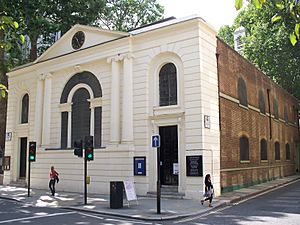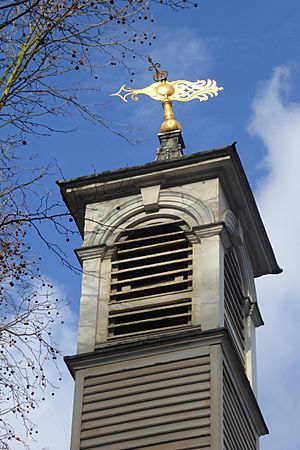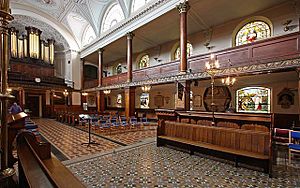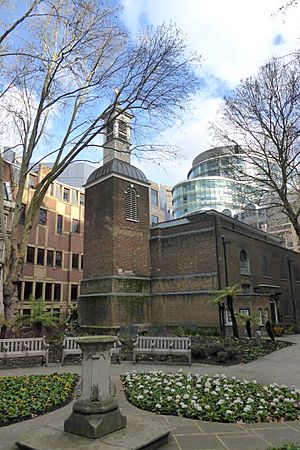St Botolph's, Aldersgate facts for kids
Quick facts for kids St Botolph's, Aldersgate |
|
|---|---|
| St Botolph without Aldersgate | |
 |
|
| Location | London, EC1 |
| Country | United Kingdom |
| Denomination | Church of England, Presbyterian |
| Architecture | |
| Heritage designation | Grade I listed building |
| Administration | |
| Diocese | London |
St Botolph without Aldersgate is a historic Church of England church in London. It is also known as St Botolph's, Aldersgate. The church is named after St Botolph and stands just outside where the old Aldersgate gate used to be in the City of London.
This church on Aldersgate Street has roots going back to the Middle Ages. It survived the Great Fire of London in 1666 with only small damage. However, it later became unsafe and was rebuilt between 1788 and 1791. The church is famous for its beautiful inside and its old organ. Today, it is also used by the London City Presbyterian Church.
Contents
Who Was Saint Botolph?
The church is named after Saint Botolph, who was an abbot and saint from the 7th century. He lived in a part of England called East Anglia.
By the end of the 11th century, people thought of Botolph as the patron saint of borders and travel. This meant he was seen as a special protector for people traveling or trading. His popularity was very high before the story of St Christopher became well-known among travelers.
There were four churches in London named after Saint Botolph. Three were just outside the city gates: Aldersgate, St Botolph-without-Bishopsgate, and St Botolph's Aldgate. A fourth, St Botolph Billingsgate, was near the docks by London Bridge. St Botolph Billingsgate was destroyed in the Great Fire of London in 1666 and was not rebuilt. These churches were often built at the edge of London, which fit with Botolph's role as a saint of boundaries and travel.
A Look at the Church's Past
The Medieval Church Building
This church was first built before the year 1291. The first priest recorded here was John de Steventon in 1333. The right to choose the priest for the church first belonged to St. Martin's-le-Grand. But when monasteries were closed down by King Henry VIII, he gave this right to the new Diocese of Westminster. Eventually, the right to choose the priest went to the dean and chapter of Westminster Abbey.
During the Middle Ages, there was a hospital for the poor near Aldersgate. It was a type of monastery that was closed down by King Henry V. Its lands and goods were then given to the parish of St Botolph.
The medieval church was built in the Gothic style. It had a main area called a nave and side areas called aisles. In 1627, the church's tall steeple was rebuilt using Portland stone. The rest of the church was also repaired. Many new benches were added, along with a new clock. These improvements cost about £415. The old church was about 24 meters (78 feet) long and 15.5 meters (51 feet) wide. The 17th-century steeple was about 20 meters (65 feet) tall and held six bells. In 1773, the church was described as having wooden galleries, oak benches, and a carved oak pulpit.
Rebuilding in the 1700s
Even though the church had only minor damage from the Great Fire of London, it became unsafe. So, it was taken down and rebuilt between 1788 and 1791. Nathaniel Wright, a surveyor for the City of London, oversaw this work. The new church was made of brick. It had a low, square bell tower at the west end, built on the old stone foundations.
The outside of the church looks quite plain. But inside, it has many beautiful features. The interior has wooden galleries supported by square columns. There is a rounded area at the east end with a half-dome ceiling. The plasterwork on the ceiling is highly decorated. At the east end, there is the only 18th-century stained glass window in the City of London. It shows The Agony in the Garden and was painted by James Pearson. Some of the stained glass in the aisles is from the Victorian era, and some is from the 1940s.
Some old monuments from the medieval church were kept. These include the tomb of Anne Packington, who passed away in 1563. The organ, located in a gallery at the west end, was made by Samuel Green in 1788.
The front of the church facing Aldersgate Street was added in 1831. It is made of a material called Roman cement. It has a triangular top part and four columns. There is also a special window with three parts in the middle. The church was repaired several times in the 1800s and 1900s. Many of the church's fittings are from the late 1800s.
The Church in Recent Times
In the mid-1980s, the church was restored by Caroe & Partners. Work on the front of the church was finished in 2008.
The Churchyard and Park
The churchyard of St Botolph's was combined with other churchyards in 1880. These areas became part of Postman's Park. This park now holds the Watts Memorial to Historic Self-Sacrifice. This memorial remembers ordinary Londoners who died bravely trying to save others.
The church was given a Grade I listed building status on January 4, 1950. This means it is a very important historic building.
How the Church is Used Today
St Botolph's is a Guild Church. This means it does not have a local parish or regular Sunday services. Instead, it holds lunchtime services during the week.
On Sundays, the London City Presbyterian Church uses the building for its services. The church is also a place where several orchestras practice their music.




